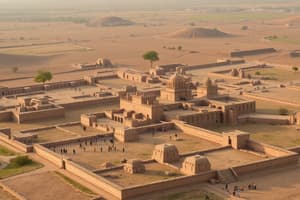Podcast
Questions and Answers
Where was the Harappan Civilization located?
Where was the Harappan Civilization located?
- In the Brahmaputra Valley region, which is now modern-day Bangladesh and northeastern India.
- In the Indus Valley region, which is now modern-day China and eastern India.
- In the Ganges Valley region, which is now modern-day southern India and Sri Lanka.
- In the Indus Valley region, which is now modern-day Pakistan and northwestern India. (correct)
What was the approximate duration of the Harappan Civilization?
What was the approximate duration of the Harappan Civilization?
- 3300 to 1300 BCE (correct)
- 2500 to 1500 BCE
- 1000 to 500 BCE
- 2000 to 1000 BCE
What was the basis of the economy of the Harappan Civilization?
What was the basis of the economy of the Harappan Civilization?
- Primarily based on trade with other regions.
- Primarily based on agriculture and craftsmanship. (correct)
- Primarily based on hunting and gathering.
- Primarily based on mining and metallurgy.
What was a distinctive feature of the cities in the Harappan Civilization?
What was a distinctive feature of the cities in the Harappan Civilization?
What is a characteristic of the social structure of the Harappan Civilization?
What is a characteristic of the social structure of the Harappan Civilization?
What is a notable feature of the art and culture of the Harappan Civilization?
What is a notable feature of the art and culture of the Harappan Civilization?
What is believed to have contributed to the decline of the Harappan Civilization?
What is believed to have contributed to the decline of the Harappan Civilization?
What is the legacy of the Harappan Civilization?
What is the legacy of the Harappan Civilization?
Flashcards are hidden until you start studying
Study Notes
Geography and Location
- The Harappan Civilization was located in the Indus Valley region, which is now modern-day Pakistan and northwestern India.
- The civilization thrived in the fertile plains of the Indus River and its tributaries.
Timeline
- The Harappan Civilization flourished from approximately 3300 to 1300 BCE, with three distinct phases:
- Early Harappan (3300-2600 BCE)
- Mature Harappan (2600-1900 BCE)
- Late Harappan (1900-1300 BCE)
Cities and Architecture
- The civilization was known for its advanced urban planning and architecture.
- Major cities included:
- Mohenjo-Daro
- Harappa
- Lothal
- Kalibangan
- Cities featured:
- Sophisticated drainage systems
- Advanced irrigation systems
- Well-planned streets and buildings
- Large public baths and granaries
Economy and Trade
- The Harappan Civilization was a Bronze Age society, with a strong economy based on:
- Agriculture (wheat, barley, rice, and cotton)
- Trade (with Mesopotamia, Egypt, and other regions)
- Craftsmanship (pottery, jewelry, and textiles)
- The civilization used a system of weights and measures, and had a standardized currency.
Social Structure and Culture
- The Harappan Civilization was a complex, urban society with a hierarchical social structure.
- The people of Harappa worshipped a variety of gods and goddesses, and had a rich cultural tradition.
- The civilization is known for its:
- Sophisticated art and crafts
- Seals and script (which have not been fully deciphered)
- Distinctive pottery and jewelry
Decline and Legacy
- The Harappan Civilization declined around 1300 BCE, likely due to a combination of factors such as:
- Environmental changes
- Drought
- Invasion by other groups
- The legacy of the Harappan Civilization can be seen in the development of subsequent Indian civilizations, including the Vedic period and the Mughal Empire.
Geography and Location
- Located in the Indus Valley region, now modern-day Pakistan and northwestern India.
- Thrived in the fertile plains of the Indus River and its tributaries.
Timeline
- Flourished from approximately 3300 to 1300 BCE.
- Three distinct phases: Early Harappan (3300-2600 BCE), Mature Harappan (2600-1900 BCE), and Late Harappan (1900-1300 BCE).
Cities and Architecture
- Known for advanced urban planning and architecture.
- Major cities: Mohenjo-Daro, Harappa, Lothal, and Kalibangan.
- City features: sophisticated drainage systems, advanced irrigation systems, well-planned streets and buildings, and large public baths and granaries.
Economy and Trade
- Bronze Age society with a strong economy based on agriculture, trade, and craftsmanship.
- Agricultural products: wheat, barley, rice, and cotton.
- Traded with Mesopotamia, Egypt, and other regions.
- Craftsmanship: pottery, jewelry, and textiles.
- Used a system of weights and measures, and had a standardized currency.
Social Structure and Culture
- Complex, urban society with a hierarchical social structure.
- Worshipped a variety of gods and goddesses.
- Rich cultural tradition: sophisticated art and crafts, seals and script (undeciphered), distinctive pottery and jewelry.
Decline and Legacy
- Declined around 1300 BCE due to environmental changes, drought, and invasion by other groups.
- Legacy seen in the development of subsequent Indian civilizations, including the Vedic period and the Mughal Empire.
Studying That Suits You
Use AI to generate personalized quizzes and flashcards to suit your learning preferences.




